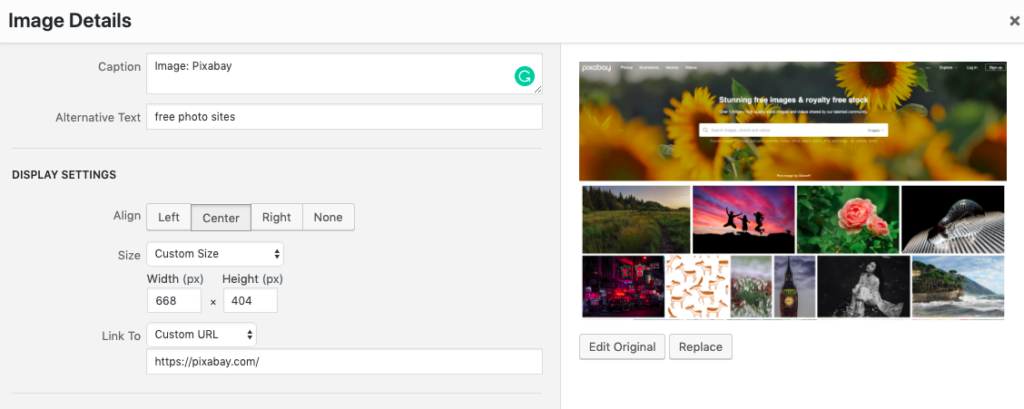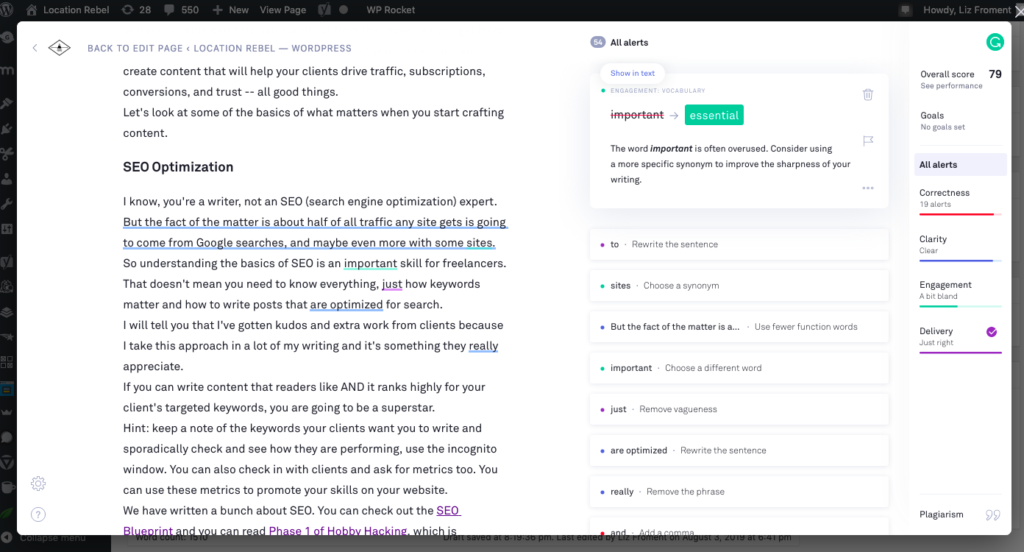What Matters When Creating Content
Once it’s time to start writing, whether you are creating a blog post or a sales page there are a couple of important things you want to pay attention to.
Going in already knowing the things that matter to both your readers and your clients can help you stand out. As you get more confident and better at writing and developing your voice, you can create content that will help your clients drive traffic, subscriptions, conversions, and trust — all good things.
Let’s look at some of the basics of what matters when you start crafting content.
SEO Optimization
I know you’re a writer, not an SEO (search engine optimization) expert. But the fact of the matter is about half of all traffic any site gets is going to come from Google searches, and maybe even more with some sites.
So understanding the basics of SEO is an important skill for freelancers. That doesn’t mean you need to know everything, just how keywords matter and how to write posts that are optimized for search.
I will tell you that I’ve gotten extra paid work from clients because I take this approach in a lot of my writing, and it’s something they really appreciate. Now, a lot of my clients are going back to old posts and optimizing them, and I'm getting paid $200-400 to read through old stuff and make SEO-friendly tweaks.
If you can write content that readers like AND ranks highly for your client’s targeted keywords, you are going to be a superstar.
Hint: keep a note of the keywords your clients want you to write and sporadically check and see how they are performing. Use the incognito window. Check with clients and ask for metrics too. Use these metrics to promote your skills on your website.
Some common things to pay attention to when writing with SEO in mind (note I said IN MIND) for a 500ish word post:
Try to include the keyword in the title so it will be in the URL as well
Try to include the keyword as one of the subheaders of the post
Sprinkle the keyword at least 1-2 times in the post with one of those in the first 100 or so words
Always link to a few other related posts from the client’s blog, I try to have at least 1-2 links (clients pretty much always end up loving this)
If you need to as part of the assignment, include the keyword in the meta description and the image alt tags
These images might help.
This is what a meta description looks like.
Here’s a great example of keeping up with SEO because now this meta description is too long.
So let’s change it.
The keyword for this post is “writing jobs online.” You can see it in the image below, I have it in the title, and it’s the URL, too, so that’s good.
I need to make a new meta, so here’s what I came up with:
We use a plugin called Yoast on this site which is pretty common for helping people see if their posts are SEO optimized.
One easy way to look like a hero to clients (and charge more) is to include meta titles and descriptions when you write your posts.
Formatting and Spacing
When you wrote assignments in school, you likely were taught to use double spacing and big paragraphs. That’s all fine because your teacher was probably printing all that stuff out and reading your papers like a book.
When it comes to reading online, you need to think differently.
Most people skim when reading online. So you need to format your content in a way that keeps eyeballs moving down the page.
Do you notice how I have lots of short paragraphs? Lots of them are only 1-2 sentences.
I also try to use subheaders (“Formatting and Spacing” is an example of a subheader), bullet points, images, and videos frequently. All that helps to keep your eyes scrolling down as you read.
You want to do the same with what you write.
Here’s an example.
Compare how this looks:
With how this looks:
That is the exact same content but who wants to read that big block of text in the second one?
No one.
I like to use subheaders about every 200-300 words.
Try to work on having more ‘white space’ in what you write. That just means breaking up big blocks of text, and use subheaders, bullet points, images, and videos liberally throughout your posts.
Images
So include pictures in your content.
Some clients want you to provide images when you write for them. If you write through something like Skyword, they have a big database of stock images you can use, so that makes it pretty simple.
If you have to source images on your own, there are a few places you can go to find them for free.
My best recommendation is a site called Pixabay. This site basically pulls in free images that don’t need attribution (meaning you don’t have to say where you go it) from all over the place.
They have standard photo images and also some cartoon-type images too.
Image: Pixabay
I always go here first, and probably about 90% of the time, I can find something that works.
Compfight and Creative Commons are other places to look for images too.
When you find an image you like, just click to download it, save the URL and paste it into the post/doc, or copy and paste the picture — however, your client wants you to do it.
Be sure you check about the attribution. Just look at the box I’ve highlighted in red.
It says ‘free for commercial use’ and ‘no attribution required,’ which means you’re in the clear.
You can also take screenshots and use those in posts too. The example above is a screenshot.
I use a tool called Awesome Screenshot. It lets me crop screenshots or write on them or add those red boxes I love so much. It’s free and works with Chrome.
If you want to make your own images, a tool like Canva is awesome and easy to use. We use it to make the featured images and a lot of the graphics on the site.
Ok, what happens if you can’t find a photo here or you want to say use an image as a graphic someone else has created?
You need to properly attribute it in your post. All that means is you want to give credit to where you go in the photo.
See the screenshot of the Pixabay homepage above? The attribution is where you see Image: Pixabay, and “Pixabay” is hyperlinked to go to the homepage of the website. You want to link to the page where you got the image whenever possible.
Here’s how you would do it inside WordPress:
You caption with the Image: and the name of the site (you can hyperlink it once it’s in the post).
In the alternative text, you want to put the keyword you’re using in the post. And you can also put the URL in the Link To section so that if someone clicks on the image in the post, it will go right to the page where you go the image.
Using Simple Language
One of the biggest things I had to work on (and still do) as I started writing was simplifying my language and not writing complex sentences.
Those might be fine for big papers, but for writing online, it’s not.
In fact, even the clients I have in finance and insurance want me to typically write at an 8th or 9th-grade level.
The same goes for keeping sentences short and simple. Use active, not passive, voice. And don’t use fancy words where simple ones will do.
Now sometimes you have to use more complex words that are industry jargon, but try to use them sparingly most of the time.
There are two really good tools I mentioned before that can help with these.
Grammarly:
I pay for the premium version of this, and it’s worth every penny, but the free version is good too. It spots spelling and grammar mistakes in everything you write.
You can see here when I check out Grammarly for what I’ve written so far, it gives me some tips and advice on how to improve my writing. So it goes way beyond spelling which is great.
Grammarly has been a lifesaver for me. I run every single thing I write through it.
Hemingway App:
Here’s a secret, most of my clients, even the fancy finance and insurance ones, want me to write in really simple language, usually at an 8th or 9th-grade reading level. This free tool helps you simplify your writing.
This is another tool I use all the time. If you have specific grade-level requirements from your clients, consider running your content through this app too.
You can see how it points out my readability which is grade 9. Let me tell you, when I started, about 95% of the stuff I wrote was college-level or beyond. Way too complicated.
It also highlights sentences that are a bit wordy, passive voice, and adverbs — whatever the hell those are.
Between both of these tools, free versions are fine, you can check your work for clear and simple writing.
Granted, neither are 100% perfect all the time, but I think they can help, especially as you start.
Include Factual Information
This one should go without saying. But there is a lot of content out there that is poorly sourced.
You can stand out from the crowd by always citing the sources for the facts and data you use in your content.
When possible, go directly to the source.
A lot of people love to make list posts — they tend to get more clicks than others. They will make a post like 25 facts about email marketing in 2023. Then they will list a bunch of facts, and rather than linking to the direct source of the fact, usually a study, they will just link to some other post that’s essentially the same topic where all the 'facts' are from 2007.
You really want to avoid doing that.
If you can’t find the right source, then consider not using that fact and finding another. If you have to use it, get as close to the original source as you can.
Don’t just make stuff up because it looks good or sounds good or helps make your point. That’s bad writing, and it can also make your client look really bad.
They are trusting you to write good info that is properly sourced, break that trust, and you can get fired (and a bad reputation).
Pay attention (or ask) to how your clients want the information to be sourced in the content you write.
Some will be ok with hyperlinking the fact:
According to a recent report, 51% of website traffic now goes through organic searches on sites like Google or Bing.
Some want the name of the source hyperlinked:
According to Brightedge, just over 50% of all website traffic is via search.
Some want the source at the end:
Did you know that approximately 51% of website traffic is through search? (source)
Source any stats or factual statements that you make. And a good rule of thumb is when in doubt, add a source.
Following Directions
Here is a very simple piece of advice.
Follow the freaking directions clients lay out for you.
Honestly.
I see this all the time. People do not like to follow directions. As a direction follower to the marrow of my bones, I do not understand. But let’s go with it for the purposes of hammering this home.
A lot of clients, especially those who work frequently with freelancers, will have what’s called content guidelines.
This is essentially a set of directions they want you to follow.
Things might include:
Writing in AP style (this is basically a set style of grammar and spelling used by a lot of brands and news orgs)
How many links to include in the post
How many pictures to include in the post (and what type are ok)
The tone they want you to write in
Words they don’t want you to use
Specific phrases they do want you to use
Competitors you can’t mention or link to
And so on.
Ignoring these will annoy your editor and client and make you look really unprofessional.
So when a client tells you they want something a certain way, give it to them that way. You can always start a conversation with them about doing things differently but don’t just overrule them as you are writing the post.
I’ve had a few clients who were fine with me tweaking things once I asked, but don’t just assume.
And, if you have any questions about their guidelines or if something feels confusing, just ask.
I can’t say this enough, always just ask if you are in doubt — don’t guess or live in confusion. Clients don’t get mad at you for wanting clarification.








